Entrepreneurship: Exploring Male and Female Entrepreneurial Styles
VerifiedAdded on 2023/03/21
|11
|2758
|96
Essay
AI Summary
This essay explores the similarities and differences between male and female entrepreneurs, drawing upon the Timmons model to highlight the characteristics of successful entrepreneurs. It identifies common traits such as autonomy, vision, management skills, and flexibility in decision-making, while also examining the distinct approaches each gender takes towards business goals, risk tolerance, financing, motivation, and networking. The essay further discusses the unique challenges faced by both male and female entrepreneurs, including funding, marketing, and work-life balance, and provides examples of successful entrepreneurs like Conrad Hilton and Ginni Rometty to illustrate key points. Ultimately, the essay concludes that while both genders share fundamental entrepreneurial qualities, their approaches and the obstacles they encounter differ significantly, shaping their paths to success.
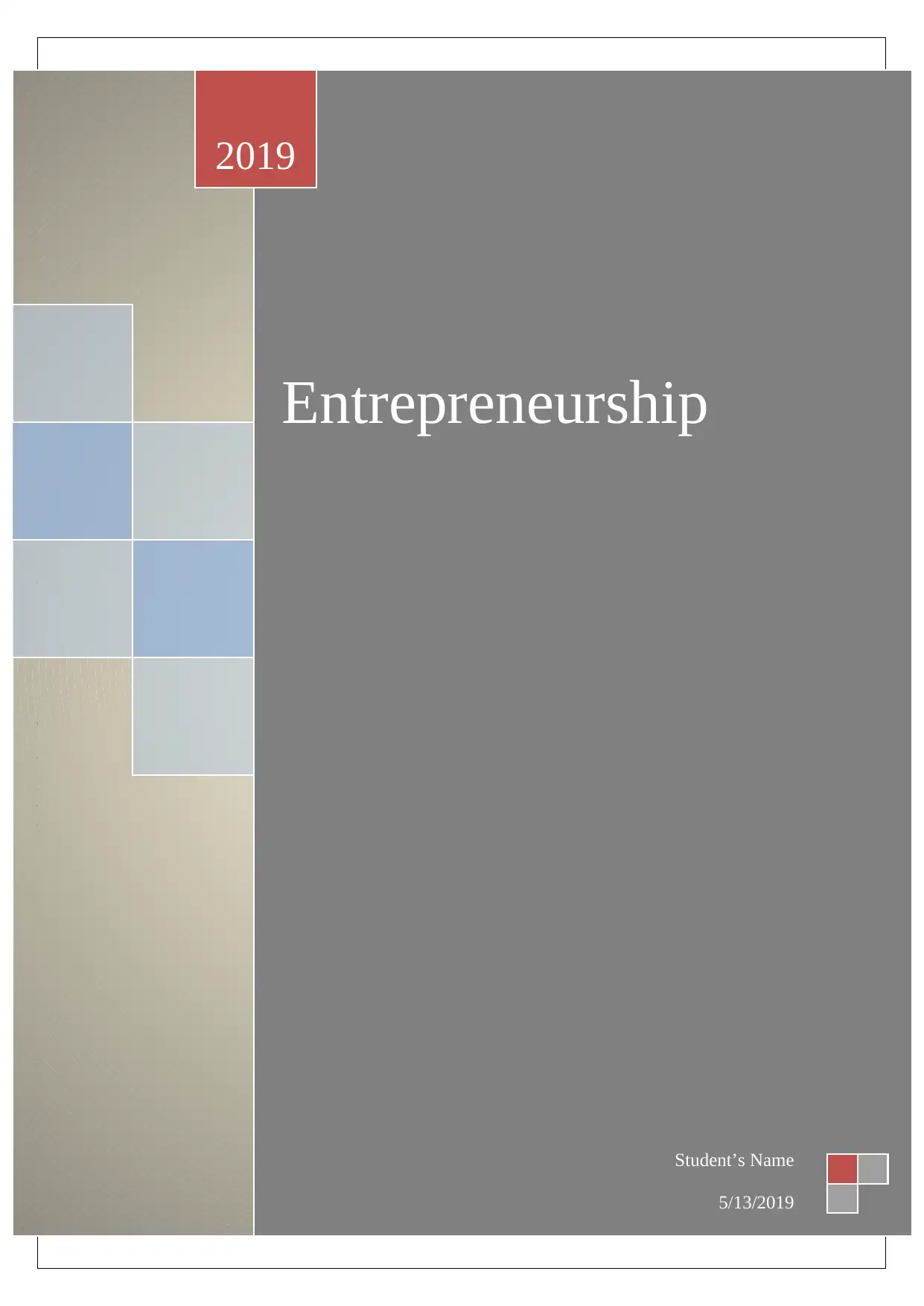
Entrepreneurship
2019
Student’s Name
5/13/2019
2019
Student’s Name
5/13/2019
Paraphrase This Document
Need a fresh take? Get an instant paraphrase of this document with our AI Paraphraser
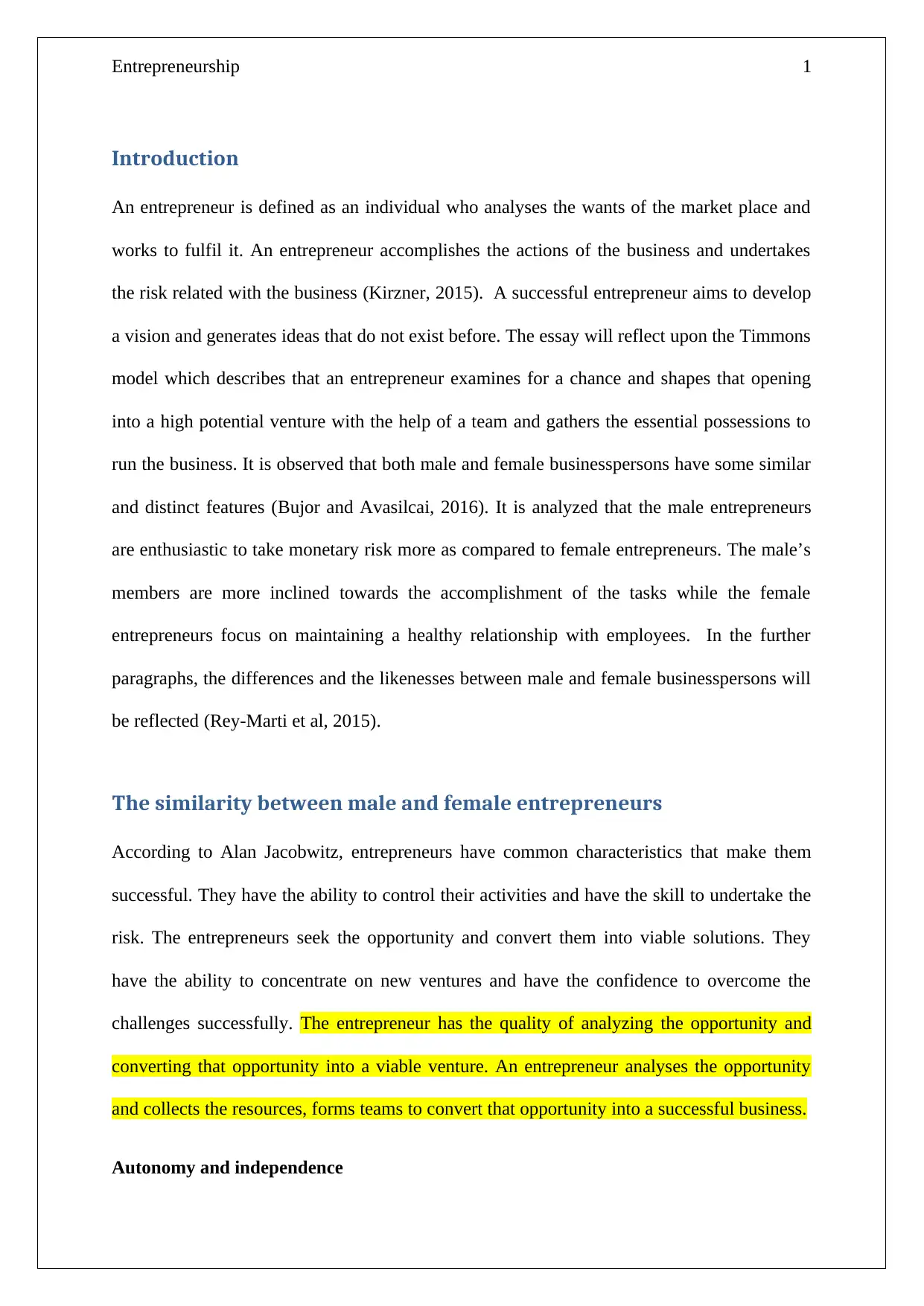
Entrepreneurship 1
Introduction
An entrepreneur is defined as an individual who analyses the wants of the market place and
works to fulfil it. An entrepreneur accomplishes the actions of the business and undertakes
the risk related with the business (Kirzner, 2015). A successful entrepreneur aims to develop
a vision and generates ideas that do not exist before. The essay will reflect upon the Timmons
model which describes that an entrepreneur examines for a chance and shapes that opening
into a high potential venture with the help of a team and gathers the essential possessions to
run the business. It is observed that both male and female businesspersons have some similar
and distinct features (Bujor and Avasilcai, 2016). It is analyzed that the male entrepreneurs
are enthusiastic to take monetary risk more as compared to female entrepreneurs. The male’s
members are more inclined towards the accomplishment of the tasks while the female
entrepreneurs focus on maintaining a healthy relationship with employees. In the further
paragraphs, the differences and the likenesses between male and female businesspersons will
be reflected (Rey-Marti et al, 2015).
The similarity between male and female entrepreneurs
According to Alan Jacobwitz, entrepreneurs have common characteristics that make them
successful. They have the ability to control their activities and have the skill to undertake the
risk. The entrepreneurs seek the opportunity and convert them into viable solutions. They
have the ability to concentrate on new ventures and have the confidence to overcome the
challenges successfully. The entrepreneur has the quality of analyzing the opportunity and
converting that opportunity into a viable venture. An entrepreneur analyses the opportunity
and collects the resources, forms teams to convert that opportunity into a successful business.
Autonomy and independence
Introduction
An entrepreneur is defined as an individual who analyses the wants of the market place and
works to fulfil it. An entrepreneur accomplishes the actions of the business and undertakes
the risk related with the business (Kirzner, 2015). A successful entrepreneur aims to develop
a vision and generates ideas that do not exist before. The essay will reflect upon the Timmons
model which describes that an entrepreneur examines for a chance and shapes that opening
into a high potential venture with the help of a team and gathers the essential possessions to
run the business. It is observed that both male and female businesspersons have some similar
and distinct features (Bujor and Avasilcai, 2016). It is analyzed that the male entrepreneurs
are enthusiastic to take monetary risk more as compared to female entrepreneurs. The male’s
members are more inclined towards the accomplishment of the tasks while the female
entrepreneurs focus on maintaining a healthy relationship with employees. In the further
paragraphs, the differences and the likenesses between male and female businesspersons will
be reflected (Rey-Marti et al, 2015).
The similarity between male and female entrepreneurs
According to Alan Jacobwitz, entrepreneurs have common characteristics that make them
successful. They have the ability to control their activities and have the skill to undertake the
risk. The entrepreneurs seek the opportunity and convert them into viable solutions. They
have the ability to concentrate on new ventures and have the confidence to overcome the
challenges successfully. The entrepreneur has the quality of analyzing the opportunity and
converting that opportunity into a viable venture. An entrepreneur analyses the opportunity
and collects the resources, forms teams to convert that opportunity into a successful business.
Autonomy and independence
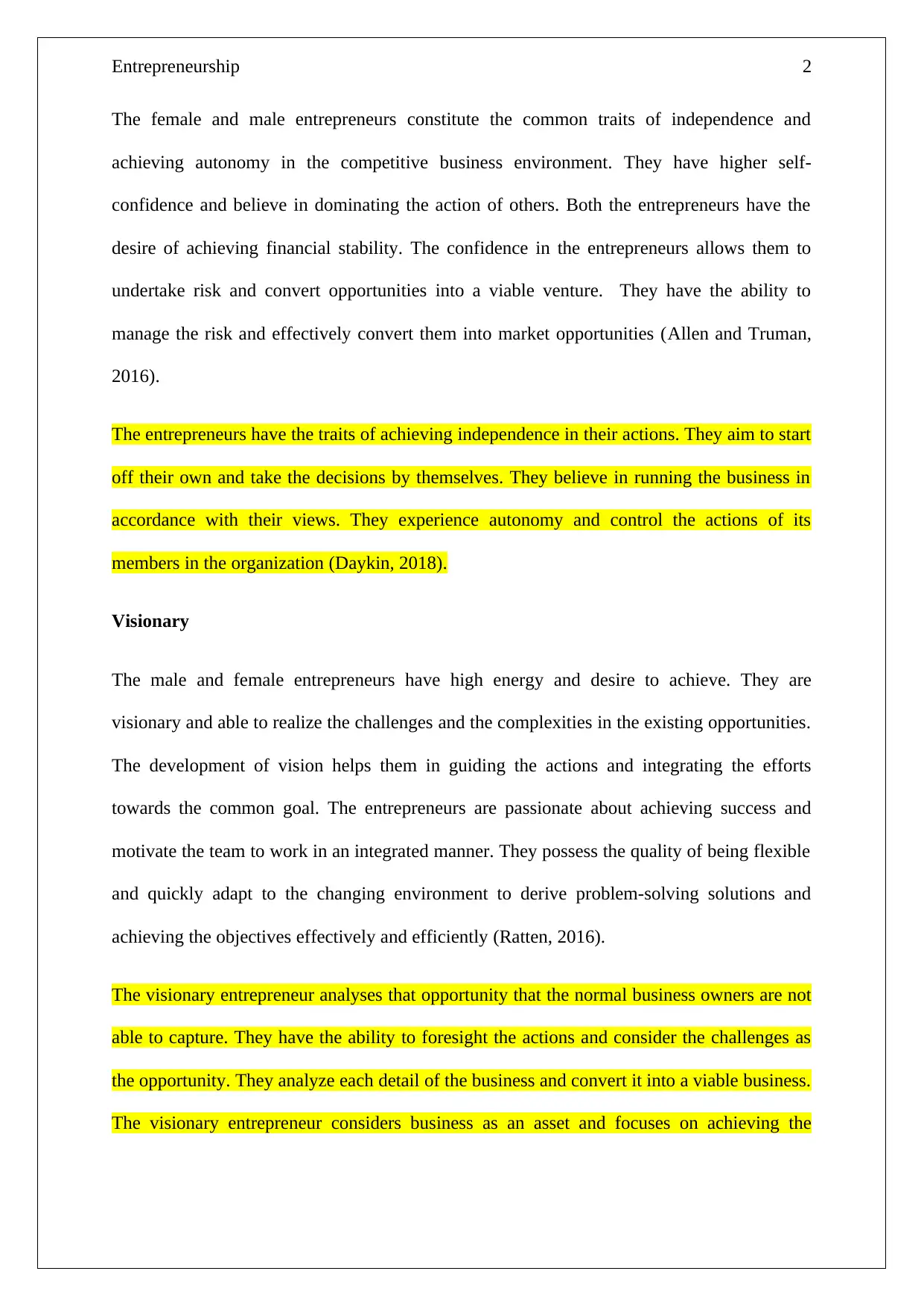
Entrepreneurship 2
The female and male entrepreneurs constitute the common traits of independence and
achieving autonomy in the competitive business environment. They have higher self-
confidence and believe in dominating the action of others. Both the entrepreneurs have the
desire of achieving financial stability. The confidence in the entrepreneurs allows them to
undertake risk and convert opportunities into a viable venture. They have the ability to
manage the risk and effectively convert them into market opportunities (Allen and Truman,
2016).
The entrepreneurs have the traits of achieving independence in their actions. They aim to start
off their own and take the decisions by themselves. They believe in running the business in
accordance with their views. They experience autonomy and control the actions of its
members in the organization (Daykin, 2018).
Visionary
The male and female entrepreneurs have high energy and desire to achieve. They are
visionary and able to realize the challenges and the complexities in the existing opportunities.
The development of vision helps them in guiding the actions and integrating the efforts
towards the common goal. The entrepreneurs are passionate about achieving success and
motivate the team to work in an integrated manner. They possess the quality of being flexible
and quickly adapt to the changing environment to derive problem-solving solutions and
achieving the objectives effectively and efficiently (Ratten, 2016).
The visionary entrepreneur analyses that opportunity that the normal business owners are not
able to capture. They have the ability to foresight the actions and consider the challenges as
the opportunity. They analyze each detail of the business and convert it into a viable business.
The visionary entrepreneur considers business as an asset and focuses on achieving the
The female and male entrepreneurs constitute the common traits of independence and
achieving autonomy in the competitive business environment. They have higher self-
confidence and believe in dominating the action of others. Both the entrepreneurs have the
desire of achieving financial stability. The confidence in the entrepreneurs allows them to
undertake risk and convert opportunities into a viable venture. They have the ability to
manage the risk and effectively convert them into market opportunities (Allen and Truman,
2016).
The entrepreneurs have the traits of achieving independence in their actions. They aim to start
off their own and take the decisions by themselves. They believe in running the business in
accordance with their views. They experience autonomy and control the actions of its
members in the organization (Daykin, 2018).
Visionary
The male and female entrepreneurs have high energy and desire to achieve. They are
visionary and able to realize the challenges and the complexities in the existing opportunities.
The development of vision helps them in guiding the actions and integrating the efforts
towards the common goal. The entrepreneurs are passionate about achieving success and
motivate the team to work in an integrated manner. They possess the quality of being flexible
and quickly adapt to the changing environment to derive problem-solving solutions and
achieving the objectives effectively and efficiently (Ratten, 2016).
The visionary entrepreneur analyses that opportunity that the normal business owners are not
able to capture. They have the ability to foresight the actions and consider the challenges as
the opportunity. They analyze each detail of the business and convert it into a viable business.
The visionary entrepreneur considers business as an asset and focuses on achieving the
⊘ This is a preview!⊘
Do you want full access?
Subscribe today to unlock all pages.

Trusted by 1+ million students worldwide
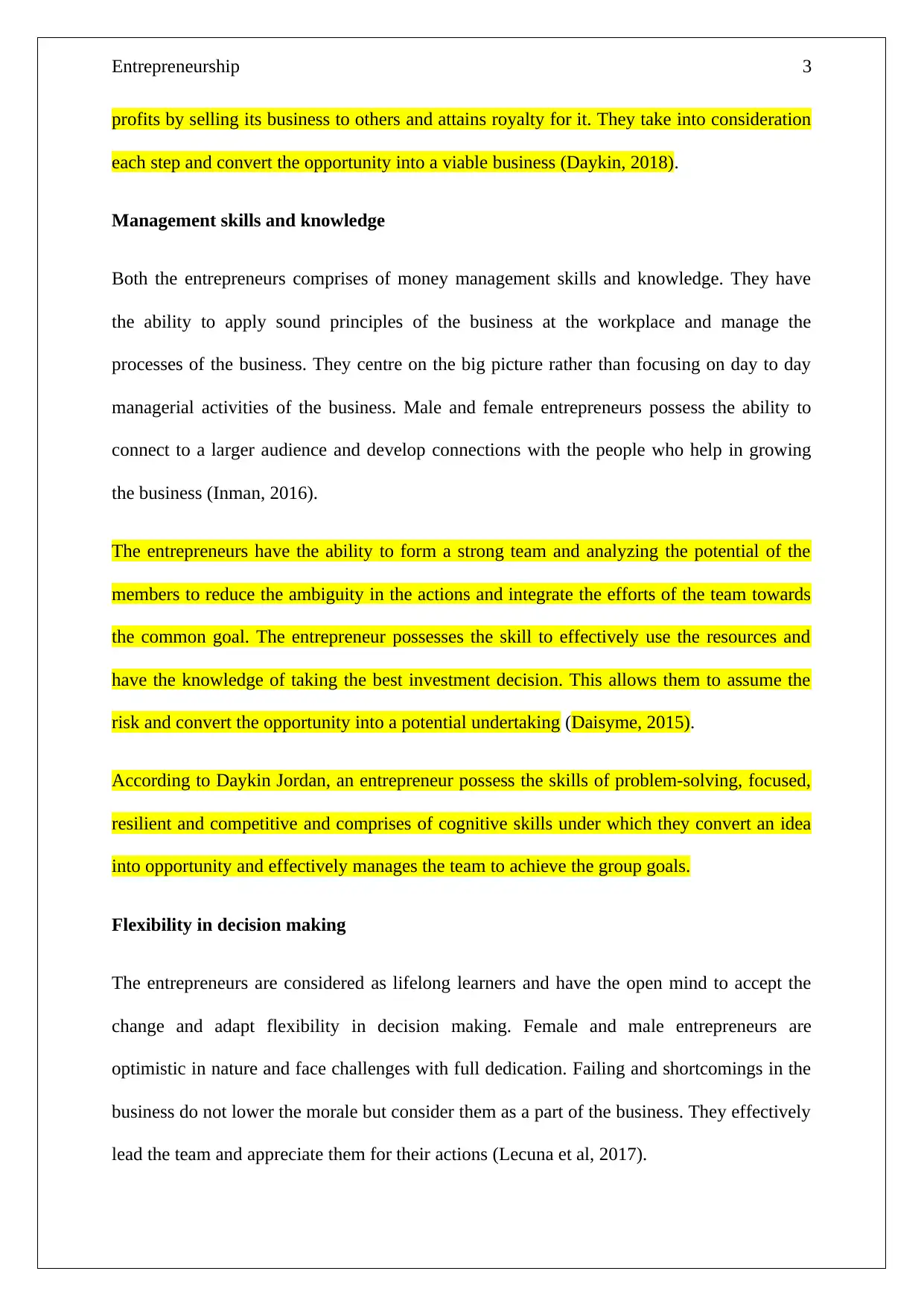
Entrepreneurship 3
profits by selling its business to others and attains royalty for it. They take into consideration
each step and convert the opportunity into a viable business (Daykin, 2018).
Management skills and knowledge
Both the entrepreneurs comprises of money management skills and knowledge. They have
the ability to apply sound principles of the business at the workplace and manage the
processes of the business. They centre on the big picture rather than focusing on day to day
managerial activities of the business. Male and female entrepreneurs possess the ability to
connect to a larger audience and develop connections with the people who help in growing
the business (Inman, 2016).
The entrepreneurs have the ability to form a strong team and analyzing the potential of the
members to reduce the ambiguity in the actions and integrate the efforts of the team towards
the common goal. The entrepreneur possesses the skill to effectively use the resources and
have the knowledge of taking the best investment decision. This allows them to assume the
risk and convert the opportunity into a potential undertaking (Daisyme, 2015).
According to Daykin Jordan, an entrepreneur possess the skills of problem-solving, focused,
resilient and competitive and comprises of cognitive skills under which they convert an idea
into opportunity and effectively manages the team to achieve the group goals.
Flexibility in decision making
The entrepreneurs are considered as lifelong learners and have the open mind to accept the
change and adapt flexibility in decision making. Female and male entrepreneurs are
optimistic in nature and face challenges with full dedication. Failing and shortcomings in the
business do not lower the morale but consider them as a part of the business. They effectively
lead the team and appreciate them for their actions (Lecuna et al, 2017).
profits by selling its business to others and attains royalty for it. They take into consideration
each step and convert the opportunity into a viable business (Daykin, 2018).
Management skills and knowledge
Both the entrepreneurs comprises of money management skills and knowledge. They have
the ability to apply sound principles of the business at the workplace and manage the
processes of the business. They centre on the big picture rather than focusing on day to day
managerial activities of the business. Male and female entrepreneurs possess the ability to
connect to a larger audience and develop connections with the people who help in growing
the business (Inman, 2016).
The entrepreneurs have the ability to form a strong team and analyzing the potential of the
members to reduce the ambiguity in the actions and integrate the efforts of the team towards
the common goal. The entrepreneur possesses the skill to effectively use the resources and
have the knowledge of taking the best investment decision. This allows them to assume the
risk and convert the opportunity into a potential undertaking (Daisyme, 2015).
According to Daykin Jordan, an entrepreneur possess the skills of problem-solving, focused,
resilient and competitive and comprises of cognitive skills under which they convert an idea
into opportunity and effectively manages the team to achieve the group goals.
Flexibility in decision making
The entrepreneurs are considered as lifelong learners and have the open mind to accept the
change and adapt flexibility in decision making. Female and male entrepreneurs are
optimistic in nature and face challenges with full dedication. Failing and shortcomings in the
business do not lower the morale but consider them as a part of the business. They effectively
lead the team and appreciate them for their actions (Lecuna et al, 2017).
Paraphrase This Document
Need a fresh take? Get an instant paraphrase of this document with our AI Paraphraser
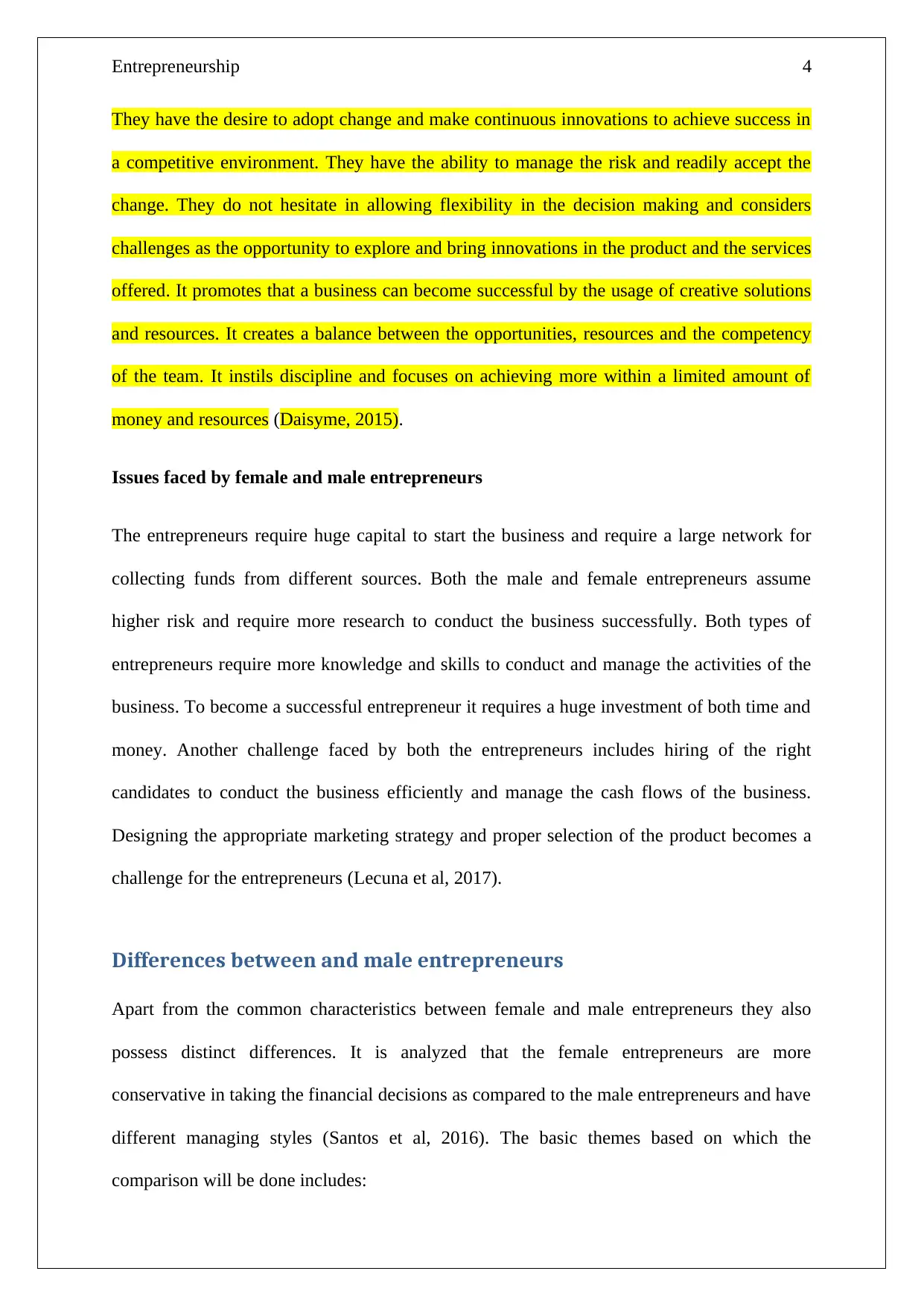
Entrepreneurship 4
They have the desire to adopt change and make continuous innovations to achieve success in
a competitive environment. They have the ability to manage the risk and readily accept the
change. They do not hesitate in allowing flexibility in the decision making and considers
challenges as the opportunity to explore and bring innovations in the product and the services
offered. It promotes that a business can become successful by the usage of creative solutions
and resources. It creates a balance between the opportunities, resources and the competency
of the team. It instils discipline and focuses on achieving more within a limited amount of
money and resources (Daisyme, 2015).
Issues faced by female and male entrepreneurs
The entrepreneurs require huge capital to start the business and require a large network for
collecting funds from different sources. Both the male and female entrepreneurs assume
higher risk and require more research to conduct the business successfully. Both types of
entrepreneurs require more knowledge and skills to conduct and manage the activities of the
business. To become a successful entrepreneur it requires a huge investment of both time and
money. Another challenge faced by both the entrepreneurs includes hiring of the right
candidates to conduct the business efficiently and manage the cash flows of the business.
Designing the appropriate marketing strategy and proper selection of the product becomes a
challenge for the entrepreneurs (Lecuna et al, 2017).
Differences between and male entrepreneurs
Apart from the common characteristics between female and male entrepreneurs they also
possess distinct differences. It is analyzed that the female entrepreneurs are more
conservative in taking the financial decisions as compared to the male entrepreneurs and have
different managing styles (Santos et al, 2016). The basic themes based on which the
comparison will be done includes:
They have the desire to adopt change and make continuous innovations to achieve success in
a competitive environment. They have the ability to manage the risk and readily accept the
change. They do not hesitate in allowing flexibility in the decision making and considers
challenges as the opportunity to explore and bring innovations in the product and the services
offered. It promotes that a business can become successful by the usage of creative solutions
and resources. It creates a balance between the opportunities, resources and the competency
of the team. It instils discipline and focuses on achieving more within a limited amount of
money and resources (Daisyme, 2015).
Issues faced by female and male entrepreneurs
The entrepreneurs require huge capital to start the business and require a large network for
collecting funds from different sources. Both the male and female entrepreneurs assume
higher risk and require more research to conduct the business successfully. Both types of
entrepreneurs require more knowledge and skills to conduct and manage the activities of the
business. To become a successful entrepreneur it requires a huge investment of both time and
money. Another challenge faced by both the entrepreneurs includes hiring of the right
candidates to conduct the business efficiently and manage the cash flows of the business.
Designing the appropriate marketing strategy and proper selection of the product becomes a
challenge for the entrepreneurs (Lecuna et al, 2017).
Differences between and male entrepreneurs
Apart from the common characteristics between female and male entrepreneurs they also
possess distinct differences. It is analyzed that the female entrepreneurs are more
conservative in taking the financial decisions as compared to the male entrepreneurs and have
different managing styles (Santos et al, 2016). The basic themes based on which the
comparison will be done includes:
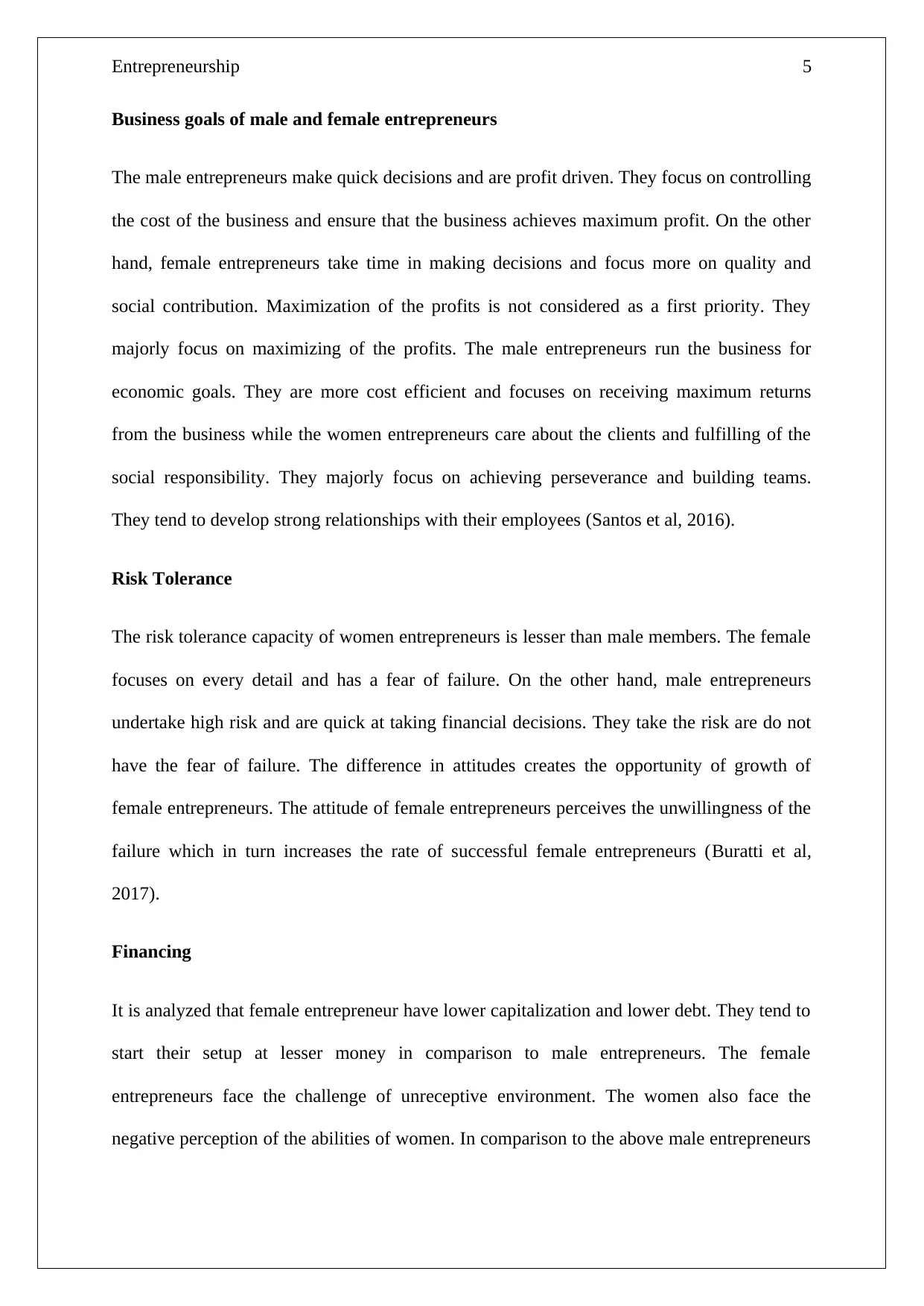
Entrepreneurship 5
Business goals of male and female entrepreneurs
The male entrepreneurs make quick decisions and are profit driven. They focus on controlling
the cost of the business and ensure that the business achieves maximum profit. On the other
hand, female entrepreneurs take time in making decisions and focus more on quality and
social contribution. Maximization of the profits is not considered as a first priority. They
majorly focus on maximizing of the profits. The male entrepreneurs run the business for
economic goals. They are more cost efficient and focuses on receiving maximum returns
from the business while the women entrepreneurs care about the clients and fulfilling of the
social responsibility. They majorly focus on achieving perseverance and building teams.
They tend to develop strong relationships with their employees (Santos et al, 2016).
Risk Tolerance
The risk tolerance capacity of women entrepreneurs is lesser than male members. The female
focuses on every detail and has a fear of failure. On the other hand, male entrepreneurs
undertake high risk and are quick at taking financial decisions. They take the risk are do not
have the fear of failure. The difference in attitudes creates the opportunity of growth of
female entrepreneurs. The attitude of female entrepreneurs perceives the unwillingness of the
failure which in turn increases the rate of successful female entrepreneurs (Buratti et al,
2017).
Financing
It is analyzed that female entrepreneur have lower capitalization and lower debt. They tend to
start their setup at lesser money in comparison to male entrepreneurs. The female
entrepreneurs face the challenge of unreceptive environment. The women also face the
negative perception of the abilities of women. In comparison to the above male entrepreneurs
Business goals of male and female entrepreneurs
The male entrepreneurs make quick decisions and are profit driven. They focus on controlling
the cost of the business and ensure that the business achieves maximum profit. On the other
hand, female entrepreneurs take time in making decisions and focus more on quality and
social contribution. Maximization of the profits is not considered as a first priority. They
majorly focus on maximizing of the profits. The male entrepreneurs run the business for
economic goals. They are more cost efficient and focuses on receiving maximum returns
from the business while the women entrepreneurs care about the clients and fulfilling of the
social responsibility. They majorly focus on achieving perseverance and building teams.
They tend to develop strong relationships with their employees (Santos et al, 2016).
Risk Tolerance
The risk tolerance capacity of women entrepreneurs is lesser than male members. The female
focuses on every detail and has a fear of failure. On the other hand, male entrepreneurs
undertake high risk and are quick at taking financial decisions. They take the risk are do not
have the fear of failure. The difference in attitudes creates the opportunity of growth of
female entrepreneurs. The attitude of female entrepreneurs perceives the unwillingness of the
failure which in turn increases the rate of successful female entrepreneurs (Buratti et al,
2017).
Financing
It is analyzed that female entrepreneur have lower capitalization and lower debt. They tend to
start their setup at lesser money in comparison to male entrepreneurs. The female
entrepreneurs face the challenge of unreceptive environment. The women also face the
negative perception of the abilities of women. In comparison to the above male entrepreneurs
⊘ This is a preview!⊘
Do you want full access?
Subscribe today to unlock all pages.

Trusted by 1+ million students worldwide
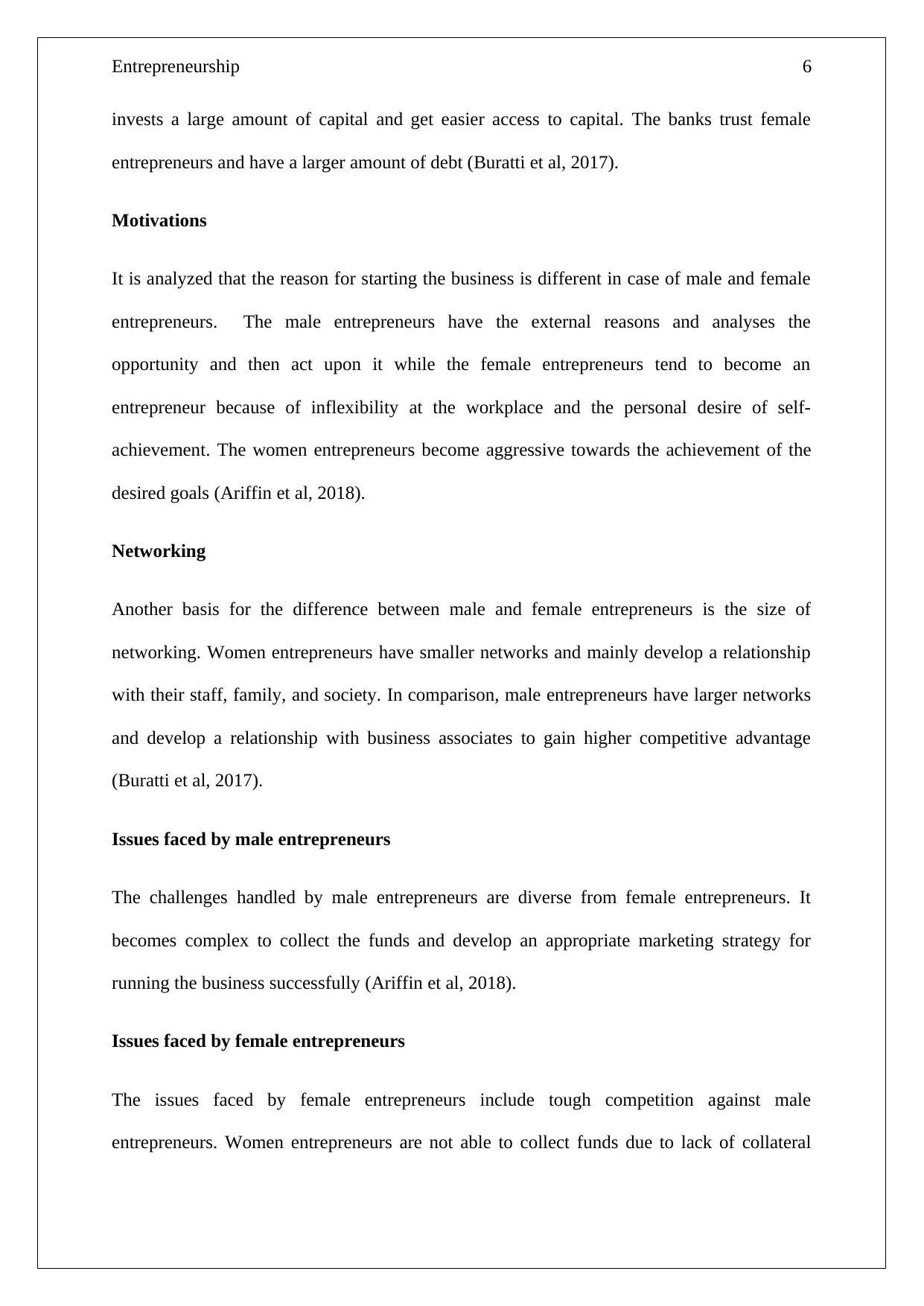
Entrepreneurship 6
invests a large amount of capital and get easier access to capital. The banks trust female
entrepreneurs and have a larger amount of debt (Buratti et al, 2017).
Motivations
It is analyzed that the reason for starting the business is different in case of male and female
entrepreneurs. The male entrepreneurs have the external reasons and analyses the
opportunity and then act upon it while the female entrepreneurs tend to become an
entrepreneur because of inflexibility at the workplace and the personal desire of self-
achievement. The women entrepreneurs become aggressive towards the achievement of the
desired goals (Ariffin et al, 2018).
Networking
Another basis for the difference between male and female entrepreneurs is the size of
networking. Women entrepreneurs have smaller networks and mainly develop a relationship
with their staff, family, and society. In comparison, male entrepreneurs have larger networks
and develop a relationship with business associates to gain higher competitive advantage
(Buratti et al, 2017).
Issues faced by male entrepreneurs
The challenges handled by male entrepreneurs are diverse from female entrepreneurs. It
becomes complex to collect the funds and develop an appropriate marketing strategy for
running the business successfully (Ariffin et al, 2018).
Issues faced by female entrepreneurs
The issues faced by female entrepreneurs include tough competition against male
entrepreneurs. Women entrepreneurs are not able to collect funds due to lack of collateral
invests a large amount of capital and get easier access to capital. The banks trust female
entrepreneurs and have a larger amount of debt (Buratti et al, 2017).
Motivations
It is analyzed that the reason for starting the business is different in case of male and female
entrepreneurs. The male entrepreneurs have the external reasons and analyses the
opportunity and then act upon it while the female entrepreneurs tend to become an
entrepreneur because of inflexibility at the workplace and the personal desire of self-
achievement. The women entrepreneurs become aggressive towards the achievement of the
desired goals (Ariffin et al, 2018).
Networking
Another basis for the difference between male and female entrepreneurs is the size of
networking. Women entrepreneurs have smaller networks and mainly develop a relationship
with their staff, family, and society. In comparison, male entrepreneurs have larger networks
and develop a relationship with business associates to gain higher competitive advantage
(Buratti et al, 2017).
Issues faced by male entrepreneurs
The challenges handled by male entrepreneurs are diverse from female entrepreneurs. It
becomes complex to collect the funds and develop an appropriate marketing strategy for
running the business successfully (Ariffin et al, 2018).
Issues faced by female entrepreneurs
The issues faced by female entrepreneurs include tough competition against male
entrepreneurs. Women entrepreneurs are not able to collect funds due to lack of collateral
Paraphrase This Document
Need a fresh take? Get an instant paraphrase of this document with our AI Paraphraser
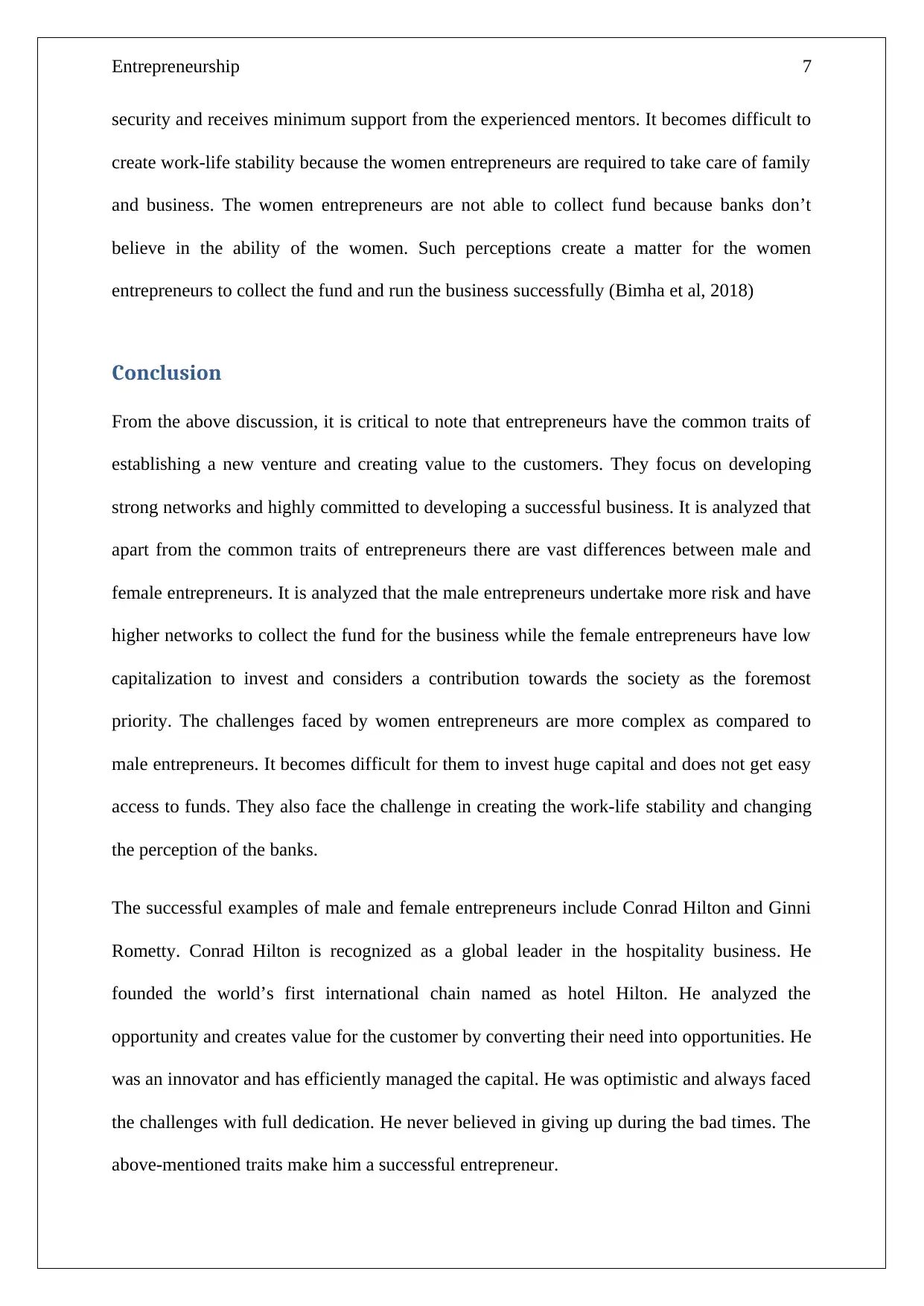
Entrepreneurship 7
security and receives minimum support from the experienced mentors. It becomes difficult to
create work-life stability because the women entrepreneurs are required to take care of family
and business. The women entrepreneurs are not able to collect fund because banks don’t
believe in the ability of the women. Such perceptions create a matter for the women
entrepreneurs to collect the fund and run the business successfully (Bimha et al, 2018)
Conclusion
From the above discussion, it is critical to note that entrepreneurs have the common traits of
establishing a new venture and creating value to the customers. They focus on developing
strong networks and highly committed to developing a successful business. It is analyzed that
apart from the common traits of entrepreneurs there are vast differences between male and
female entrepreneurs. It is analyzed that the male entrepreneurs undertake more risk and have
higher networks to collect the fund for the business while the female entrepreneurs have low
capitalization to invest and considers a contribution towards the society as the foremost
priority. The challenges faced by women entrepreneurs are more complex as compared to
male entrepreneurs. It becomes difficult for them to invest huge capital and does not get easy
access to funds. They also face the challenge in creating the work-life stability and changing
the perception of the banks.
The successful examples of male and female entrepreneurs include Conrad Hilton and Ginni
Rometty. Conrad Hilton is recognized as a global leader in the hospitality business. He
founded the world’s first international chain named as hotel Hilton. He analyzed the
opportunity and creates value for the customer by converting their need into opportunities. He
was an innovator and has efficiently managed the capital. He was optimistic and always faced
the challenges with full dedication. He never believed in giving up during the bad times. The
above-mentioned traits make him a successful entrepreneur.
security and receives minimum support from the experienced mentors. It becomes difficult to
create work-life stability because the women entrepreneurs are required to take care of family
and business. The women entrepreneurs are not able to collect fund because banks don’t
believe in the ability of the women. Such perceptions create a matter for the women
entrepreneurs to collect the fund and run the business successfully (Bimha et al, 2018)
Conclusion
From the above discussion, it is critical to note that entrepreneurs have the common traits of
establishing a new venture and creating value to the customers. They focus on developing
strong networks and highly committed to developing a successful business. It is analyzed that
apart from the common traits of entrepreneurs there are vast differences between male and
female entrepreneurs. It is analyzed that the male entrepreneurs undertake more risk and have
higher networks to collect the fund for the business while the female entrepreneurs have low
capitalization to invest and considers a contribution towards the society as the foremost
priority. The challenges faced by women entrepreneurs are more complex as compared to
male entrepreneurs. It becomes difficult for them to invest huge capital and does not get easy
access to funds. They also face the challenge in creating the work-life stability and changing
the perception of the banks.
The successful examples of male and female entrepreneurs include Conrad Hilton and Ginni
Rometty. Conrad Hilton is recognized as a global leader in the hospitality business. He
founded the world’s first international chain named as hotel Hilton. He analyzed the
opportunity and creates value for the customer by converting their need into opportunities. He
was an innovator and has efficiently managed the capital. He was optimistic and always faced
the challenges with full dedication. He never believed in giving up during the bad times. The
above-mentioned traits make him a successful entrepreneur.
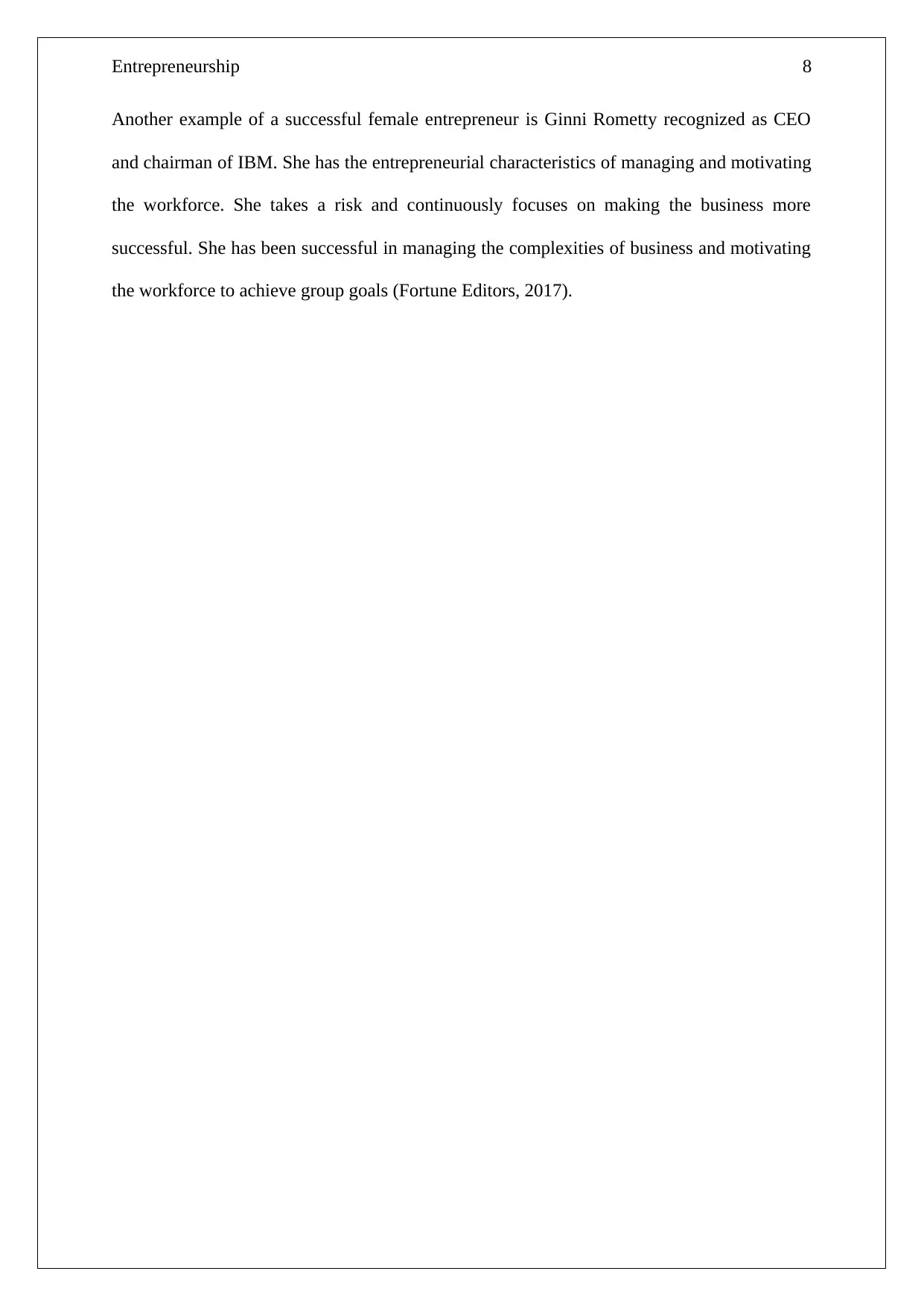
Entrepreneurship 8
Another example of a successful female entrepreneur is Ginni Rometty recognized as CEO
and chairman of IBM. She has the entrepreneurial characteristics of managing and motivating
the workforce. She takes a risk and continuously focuses on making the business more
successful. She has been successful in managing the complexities of business and motivating
the workforce to achieve group goals (Fortune Editors, 2017).
Another example of a successful female entrepreneur is Ginni Rometty recognized as CEO
and chairman of IBM. She has the entrepreneurial characteristics of managing and motivating
the workforce. She takes a risk and continuously focuses on making the business more
successful. She has been successful in managing the complexities of business and motivating
the workforce to achieve group goals (Fortune Editors, 2017).
⊘ This is a preview!⊘
Do you want full access?
Subscribe today to unlock all pages.

Trusted by 1+ million students worldwide
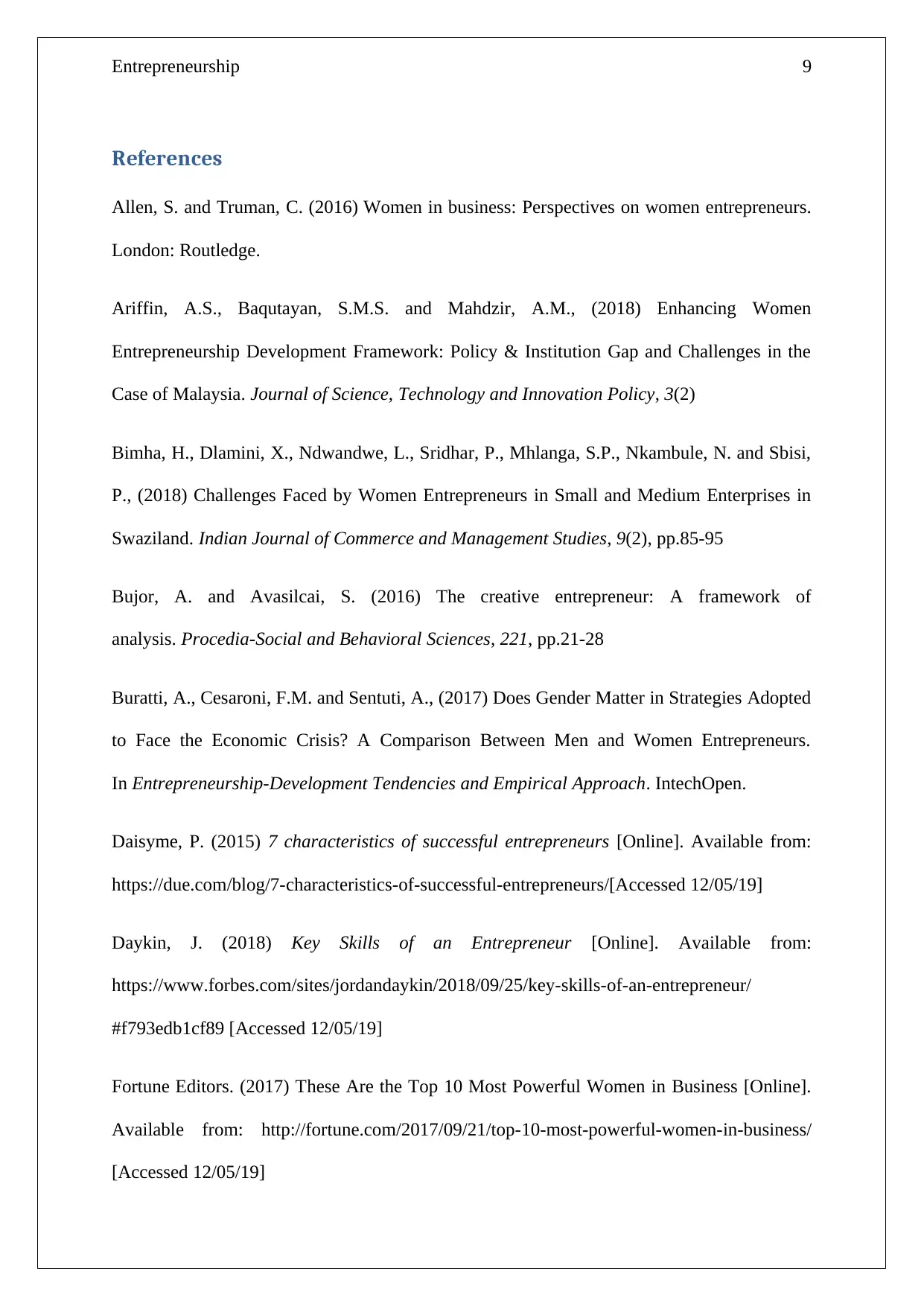
Entrepreneurship 9
References
Allen, S. and Truman, C. (2016) Women in business: Perspectives on women entrepreneurs.
London: Routledge.
Ariffin, A.S., Baqutayan, S.M.S. and Mahdzir, A.M., (2018) Enhancing Women
Entrepreneurship Development Framework: Policy & Institution Gap and Challenges in the
Case of Malaysia. Journal of Science, Technology and Innovation Policy, 3(2)
Bimha, H., Dlamini, X., Ndwandwe, L., Sridhar, P., Mhlanga, S.P., Nkambule, N. and Sbisi,
P., (2018) Challenges Faced by Women Entrepreneurs in Small and Medium Enterprises in
Swaziland. Indian Journal of Commerce and Management Studies, 9(2), pp.85-95
Bujor, A. and Avasilcai, S. (2016) The creative entrepreneur: A framework of
analysis. Procedia-Social and Behavioral Sciences, 221, pp.21-28
Buratti, A., Cesaroni, F.M. and Sentuti, A., (2017) Does Gender Matter in Strategies Adopted
to Face the Economic Crisis? A Comparison Between Men and Women Entrepreneurs.
In Entrepreneurship-Development Tendencies and Empirical Approach. IntechOpen.
Daisyme, P. (2015) 7 characteristics of successful entrepreneurs [Online]. Available from:
https://due.com/blog/7-characteristics-of-successful-entrepreneurs/[Accessed 12/05/19]
Daykin, J. (2018) Key Skills of an Entrepreneur [Online]. Available from:
https://www.forbes.com/sites/jordandaykin/2018/09/25/key-skills-of-an-entrepreneur/
#f793edb1cf89 [Accessed 12/05/19]
Fortune Editors. (2017) These Are the Top 10 Most Powerful Women in Business [Online].
Available from: http://fortune.com/2017/09/21/top-10-most-powerful-women-in-business/
[Accessed 12/05/19]
References
Allen, S. and Truman, C. (2016) Women in business: Perspectives on women entrepreneurs.
London: Routledge.
Ariffin, A.S., Baqutayan, S.M.S. and Mahdzir, A.M., (2018) Enhancing Women
Entrepreneurship Development Framework: Policy & Institution Gap and Challenges in the
Case of Malaysia. Journal of Science, Technology and Innovation Policy, 3(2)
Bimha, H., Dlamini, X., Ndwandwe, L., Sridhar, P., Mhlanga, S.P., Nkambule, N. and Sbisi,
P., (2018) Challenges Faced by Women Entrepreneurs in Small and Medium Enterprises in
Swaziland. Indian Journal of Commerce and Management Studies, 9(2), pp.85-95
Bujor, A. and Avasilcai, S. (2016) The creative entrepreneur: A framework of
analysis. Procedia-Social and Behavioral Sciences, 221, pp.21-28
Buratti, A., Cesaroni, F.M. and Sentuti, A., (2017) Does Gender Matter in Strategies Adopted
to Face the Economic Crisis? A Comparison Between Men and Women Entrepreneurs.
In Entrepreneurship-Development Tendencies and Empirical Approach. IntechOpen.
Daisyme, P. (2015) 7 characteristics of successful entrepreneurs [Online]. Available from:
https://due.com/blog/7-characteristics-of-successful-entrepreneurs/[Accessed 12/05/19]
Daykin, J. (2018) Key Skills of an Entrepreneur [Online]. Available from:
https://www.forbes.com/sites/jordandaykin/2018/09/25/key-skills-of-an-entrepreneur/
#f793edb1cf89 [Accessed 12/05/19]
Fortune Editors. (2017) These Are the Top 10 Most Powerful Women in Business [Online].
Available from: http://fortune.com/2017/09/21/top-10-most-powerful-women-in-business/
[Accessed 12/05/19]
Paraphrase This Document
Need a fresh take? Get an instant paraphrase of this document with our AI Paraphraser
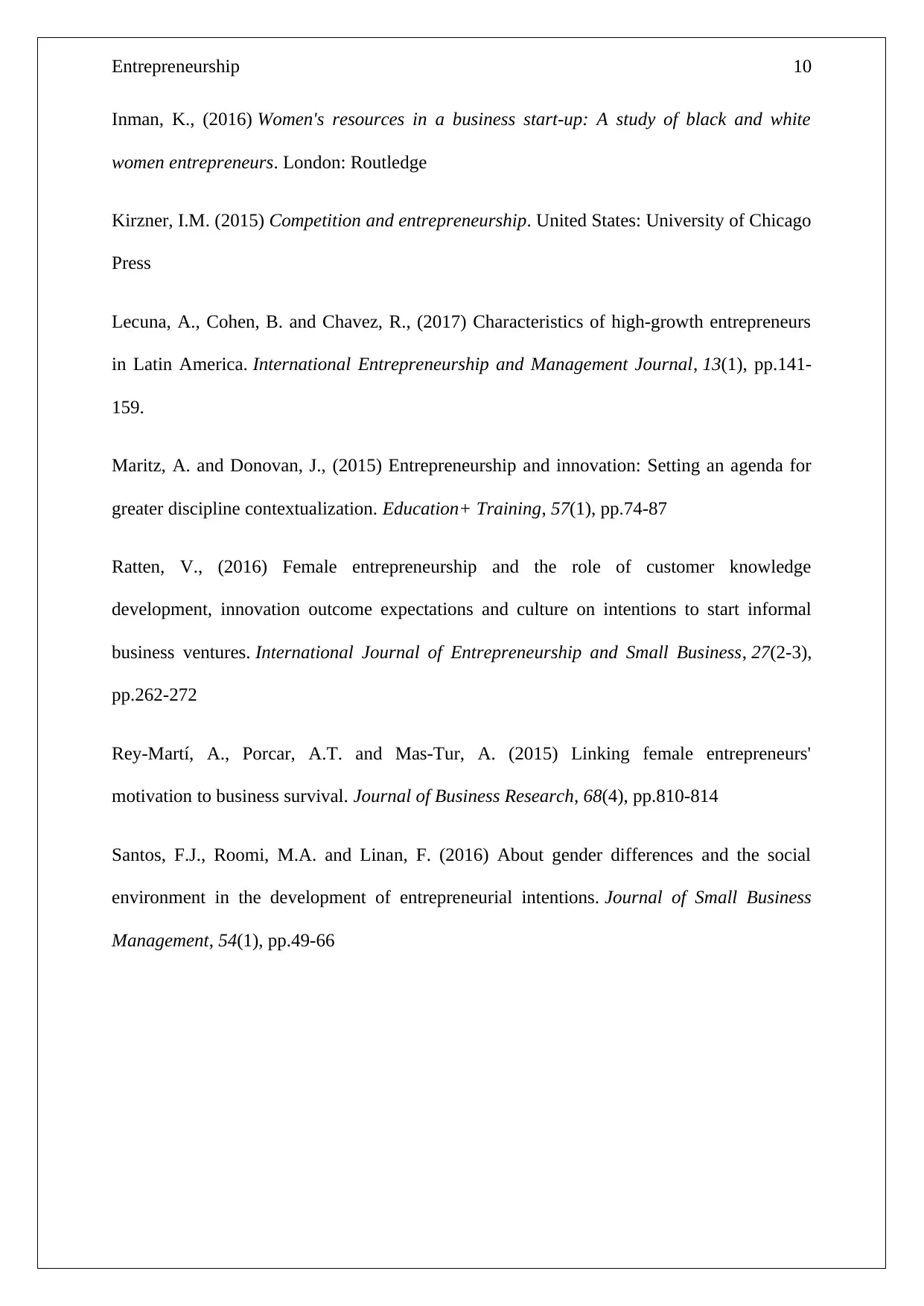
Entrepreneurship 10
Inman, K., (2016) Women's resources in a business start-up: A study of black and white
women entrepreneurs. London: Routledge
Kirzner, I.M. (2015) Competition and entrepreneurship. United States: University of Chicago
Press
Lecuna, A., Cohen, B. and Chavez, R., (2017) Characteristics of high-growth entrepreneurs
in Latin America. International Entrepreneurship and Management Journal, 13(1), pp.141-
159.
Maritz, A. and Donovan, J., (2015) Entrepreneurship and innovation: Setting an agenda for
greater discipline contextualization. Education+ Training, 57(1), pp.74-87
Ratten, V., (2016) Female entrepreneurship and the role of customer knowledge
development, innovation outcome expectations and culture on intentions to start informal
business ventures. International Journal of Entrepreneurship and Small Business, 27(2-3),
pp.262-272
Rey-Martí, A., Porcar, A.T. and Mas-Tur, A. (2015) Linking female entrepreneurs'
motivation to business survival. Journal of Business Research, 68(4), pp.810-814
Santos, F.J., Roomi, M.A. and Linan, F. (2016) About gender differences and the social
environment in the development of entrepreneurial intentions. Journal of Small Business
Management, 54(1), pp.49-66
Inman, K., (2016) Women's resources in a business start-up: A study of black and white
women entrepreneurs. London: Routledge
Kirzner, I.M. (2015) Competition and entrepreneurship. United States: University of Chicago
Press
Lecuna, A., Cohen, B. and Chavez, R., (2017) Characteristics of high-growth entrepreneurs
in Latin America. International Entrepreneurship and Management Journal, 13(1), pp.141-
159.
Maritz, A. and Donovan, J., (2015) Entrepreneurship and innovation: Setting an agenda for
greater discipline contextualization. Education+ Training, 57(1), pp.74-87
Ratten, V., (2016) Female entrepreneurship and the role of customer knowledge
development, innovation outcome expectations and culture on intentions to start informal
business ventures. International Journal of Entrepreneurship and Small Business, 27(2-3),
pp.262-272
Rey-Martí, A., Porcar, A.T. and Mas-Tur, A. (2015) Linking female entrepreneurs'
motivation to business survival. Journal of Business Research, 68(4), pp.810-814
Santos, F.J., Roomi, M.A. and Linan, F. (2016) About gender differences and the social
environment in the development of entrepreneurial intentions. Journal of Small Business
Management, 54(1), pp.49-66
1 out of 11
Related Documents
Your All-in-One AI-Powered Toolkit for Academic Success.
+13062052269
info@desklib.com
Available 24*7 on WhatsApp / Email
![[object Object]](/_next/static/media/star-bottom.7253800d.svg)
Unlock your academic potential
Copyright © 2020–2025 A2Z Services. All Rights Reserved. Developed and managed by ZUCOL.





